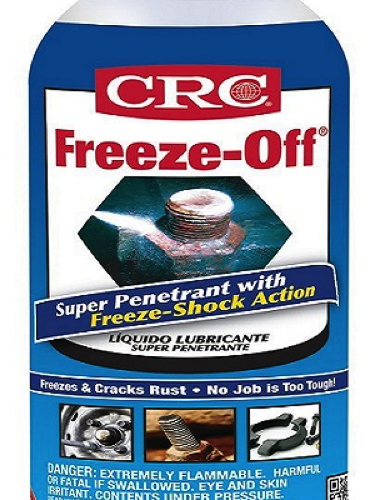Five Miracle Lubricants Used for DIY Auto Repairs
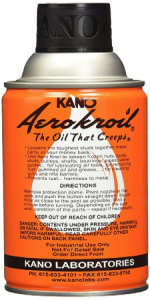 It can be hard to believe that anything in a can help you get through an auto repair and achieve better results. But I’m here to tell you that it’s true. In this article we’ll talk about five miracle lubricants used in everyday auto repairs.
It can be hard to believe that anything in a can help you get through an auto repair and achieve better results. But I’m here to tell you that it’s true. In this article we’ll talk about five miracle lubricants used in everyday auto repairs.
Not only will we cover how and when they’re used, but we’ll also dig into the science engineered into some of the individual products. In addition, we’ll discuss best practices to get the most out of the engineering designed into the lube. In the end, we hope that you’ll see the value of keeping these mechanics little helpers on the shelf in your DIY garage.
Penetrating Oil for Loosening Rusty Bolts
When it comes to DIY auto repairs we often find ourselves replacing parts held in place with rusty nuts and bolts. The old saying is that rust never sleeps. Although oxidation of metal surfaces is unavoidable a lot of people don’t realize that your geographical location plays a big role in how severe the problem is.
Those living in Arizona will find a lot less rust standing in their way than those living on the Gulf Coast in a salt air and humid environment. With that said, a can of penetrating oil might last longer in Arizona, but it still has a place in everyone’s garage.
Products like Liquid Wrench, Aero Kroil from Kano Labs or PB blaster are designed to penetrate rust. They lubricate the threads of both nuts and bolts at the same time. When you walk up to a rusty nut and spray it down you immediately see the problem. The penetrating oil doesn’t land on the parts you need to loosen the most. It’s the unseen threads inside that are causing the issue.
The science behind these penetrating oils is that they have a capillary effect or the ability to wick themselves into the areas that you can’t see. The slogan for Aero Kroil from Kano Labs is the oil that creeps. You can actually see this process work if you spray the threads of a rusty bolt. Watch and wait as the product magically crawls up on the threads that you didn’t spray.
To achieve the maximum benefit of this wicking affect you need to keep the area wet with the product. This will continually feed penetrating oil into the areas that you can’t see. The next question is how long do you need to let the product soak in before reaching the maximum benefit. Although this will depend on the individual situation, I shoot for 15 minutes to a half-hour with several soakings during that period of time. The key is to keep the area wet because when it dries there is no additional wicking.
Additional Products for Breaking Loose Rusty Threads
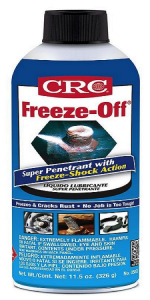 Although penetrating oils are extremely popular they don’t always work in the most extreme situations. When the bolt has to come off and the penetrating oil has failed, experienced mechanics know that it’s time to change the temperature of those rusty parts. Heating the nut and bolt with a torch will cause the metal to expand and this can help break the threads loose.
Although penetrating oils are extremely popular they don’t always work in the most extreme situations. When the bolt has to come off and the penetrating oil has failed, experienced mechanics know that it’s time to change the temperature of those rusty parts. Heating the nut and bolt with a torch will cause the metal to expand and this can help break the threads loose.
Not everybody has a torch or feels comfortable with using it in certain situations. In fact, you should never fire up a torch near fuel lines or a gas tank. Companies have developed products that take the temperature change in the opposite direction. Instead of using a torch to expand the metal they use extreme cold to contract the metal surfaces in an effort to break the threads loose.
There are a few companies that make products in this category. The CRC product is called Freeze Off. Loctite also offers a spray called Freeze and Release. Both of these products strive to bring the temperature of the metals down below -50 degrees Fahrenheit. They call this the shock-freeze effect.
The advantageous science behind the product causes microscopic cracks in the top layer of rust. This allows the formulated lubricating ingredient to wick directly into the rust by capillary action as mentioned above. This dual action of first contracting the metal and then allowing this space to fill with a penetrating lubricant can break the corrosion’s hold on some really stuck nuts and bolts.
The downside of these miracle freezing and lubricating fluids will hit you right in the wallet. A can of Liquid Wrench comes in at around three dollars. However, the freezing fluids are offered in the $12-$16 price range for the same size can. Another thing to note in the expense department is you’ll use more of the product when you attempt to chill down these rusty parts. The can disappears quickly as you hold down on the trigger to soak the offending rusty bolt. With that said, if they get the job done and allow you to extract the bolt without damaging the threads, then they could be worth their weight in gold.
White Lithium Grease in a Spray Can
The big advantage to using white lithium grease remains its ability to stay where you put it. It’s water resistant and the lubricating capabilities hold up well in a wide range of temperatures. When applied with a spray can it leaves a creamy white coating that allows you to see where it landed and where it didn’t.
The science behind the white lithium grease that comes in a spray can go back a couple of decades. Lithium is actually a non-detergent soup product that provides excellent lubrication qualities. It holds up well under pressure and is temperature resistant. It also contains zero corrosive chemicals. You can certainly use it around your house on garage door rollers and tracks, plus a variety of door hinges found inside the average home.
On the automobile it’s an excellent lubricant for latch assemblies and door hinges. The hood latch and trunk latch are often overlooked locking mechanisms that require occasional lubrication. In addition door latches benefit from an occasional spray of white lithium grease. Mechanics recommend that you hit the door hinges and latches on the automobile once a year with a shot of white lithium grease.
WD-40 Lubrication Spray
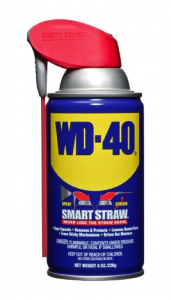 Probably the most recognized type of spray lubricant is the WD-40 brand. What a lot of people don’t know is that the WD stands for water displacement and the 40 stands for the formulation or secret recipe. Somehow this 65 year old formula remains a secret today. You can tell it’s different from other spray can lubricants because it dries faster than the other lubricants mentioned on this page.
Probably the most recognized type of spray lubricant is the WD-40 brand. What a lot of people don’t know is that the WD stands for water displacement and the 40 stands for the formulation or secret recipe. Somehow this 65 year old formula remains a secret today. You can tell it’s different from other spray can lubricants because it dries faster than the other lubricants mentioned on this page.
It also has a unique smell and feel when you squeeze it between your fingers. When the WD-40 dissipates it leaves a protective residue that can inhibit corrosion. However, this layer of protection is mighty thin and only resists moisture. Putting it another way, this stuff will eventually wash off and will need frequent reapplication. The upside to this type of product is it doesn’t attract or hold dirt in the way that the white lithium grease will.
After its invention 1953 it finally hit shelves in 1958 for retail sale. Ever since that day people have found ingenious uses for the WD-40 product. The military even sent it to soldiers in Vietnam on the front lines to protect their firearms from the jungle moisture. By the mid-1990s a can of WD-40 could be found in four out of five American homes. As far as the automotive applications they do abound.
Car detailers swear by the product for removing tree sap, bird droppings and stains from dead bugs. Sticking to the exterior finish theme, WD-40 is also an excellent cleaner for the black weather strips you’ll find throughout the automobile. Under the hood it’s good for displacing water from ignition components like distributor caps, spark plug wires and rotors. It performs well on exterior transmission linkages and even control arm bushings because it doesn’t attract dirt that will wear away at the nylon and rubber bushings.
Before we move on to our next and final must have lubricant I wanted to mention a few under the radar uses for the WD-40 product at home. Of course you can use this product to help waterproof boots and shoes. In addition, it does a fine job at cleaning lime stains and corrosion in the toilet bowl. A lot of people don’t know that it’s a pretty good bug killer. If you hit a roach with the wonder liquid he won’t last long. In fact, it works on almost any type of bug or spider.
My neighbor uses it to coat her bird feeder that hangs from a tree. The slippery surface prevents squirrels from getting a good grip and thereby leaving the bird food for the birds. Finally a personal experience, after years of wearing her wedding ring my mother’s knuckle began to swell from arthritis. We used WD-40 to get the ring off her swollen finger.
Specialized Disc Brake Caliper Lube
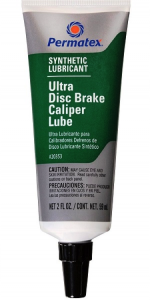 There is one area of the automobile where you need to use a specialized lubricant and there is no substitute for it. I speak of the automotive braking system. Specialized disc brake caliper lube should be the only type of grease that you use on the caliper slides, sleeves, bushings, pistons and guide pins.
There is one area of the automobile where you need to use a specialized lubricant and there is no substitute for it. I speak of the automotive braking system. Specialized disc brake caliper lube should be the only type of grease that you use on the caliper slides, sleeves, bushings, pistons and guide pins.
The science behind a specialized caliper lube is its ability to hold up under extreme heat that’s generated by a disc brake caliper. Sidebar: Automotive braking systems use friction to stop the automobile. Friction generates large amounts of heat. The disc brake rotors and the brake pads themselves can reach temperatures above 400 degrees Fahrenheit during normal operation.
Temperatures this high will turn most lubricants into a liquid. When it liquefies gravity will pull them down over the pads and rotors. Lubricating these friction surfaces can increase stopping distances, generate noise and ultimately destroy the rotors and pads. This will not happen with the specialized caliper lube because it is a non-melting synthetic lubricant. In addition to its ability to survive extreme heat it holds up well against moisture. Disc brake calipers see heavy service through all kinds of road conditions.
How long will the lubrication last? First let’s talk about the proper way to use this product. It is meant to be applied to a perfectly clean surface. This allows it to adhere as per the design intent. You must clean the caliper bushings, slides and retaining pins before applying the caliper lube. Properly lubricated caliper components should stay that way for the life of the brake pads. In other words, if you use the right stuff you only have to apply it during a brake job. As a professional mechanic I can tell you that a little bit of this stuff goes a long way and lasts a long time.
For me, an 8 ounce bottle of Permatex ultra disc brake caliper lube lasts a couple of years and I do a lot of brake jobs. Unfortunately, an 8 to 10 ounce canister of the product is rather pricy at around the $15-$20 range. However, as I mentioned previously there is no substitute for a quality brake caliper lubricant. Some people think that a high temperature wheel bearing grease can be substituted for this product. This is not true as high temperature bearing grease will liquefy at temperatures over 350 degrees Fahrenheit.
Several manufacturers make synthetic brake lubricants including CRC, Permatex and Gunk. After using several different brands over the years I believe they are fairly consistent in their quality. They are all an attractive shade of green. This unique color helps distinguish caliper lube from other types of lubricants. It’s recommended that you wear a pair of safety gloves when working with this product as the synthetic chemical can be irritating to the skin. Its superior waterproof protection also makes it an excellent choice for lubricating components on all-terrain vehicles, snowmobiles, personal watercraft and motorcycles.


